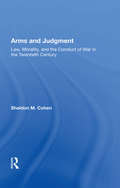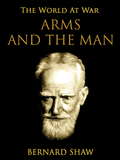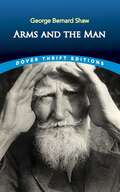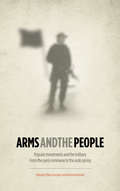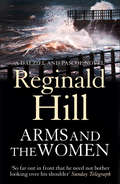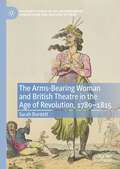- Table View
- List View
Arms and Innovation: Entrepreneurship and Alliances in the Twenty-First Century Defense Industry
by James HasikWith many of the most important new military systems of the past decade produced by small firms that won competitive government contracts, defense-industry consultant James Hasik argues in Arms and Innovation that small firms have a number of advantages relative to their bigger competitors. Such firms are marked by an entrepreneurial spirit and fewer bureaucratic obstacles, and thus can both be more responsive to changes in the environment and more strategic in their planning. This is demonstrated, Hasik shows, by such innovation in military technologies as those that protect troops from roadside bombs in Iraq and the Predator drones that fly over active war zones and that are crucial to our new war on terror. For all their advantages, small firms also face significant challenges in access to capital and customers. To overcome such problems, they can form alliances either with each other or with larger companies. Hasik traces the trade-offs of such alliances and provides crucial insight into their promises and pitfalls. This ground-breaking study is a significant contribution to understanding both entrepreneurship and alliances, two crucial factors in business generally. It will be of interest to readers in the defense sector as well as the wider business community.
Arms And Judgment: Law, Morality, And The Conduct Of War In The 20th Century
by Sheldon M. CohenThis book examines the justifications of the use of armed force and their limits, as well as the law of war. It is a moral enquiry and adopts an interdisciplinary approach. The divergence between legality and morality, and its significance, is one of the underlying themes of the book.
Arms And Judgment: Law, Morality, And The Conduct Of War In The 20th Century
by Sheldon M. CohenThis book examines the justifications of the use of armed force and their limits, as well as the law of war. It is a moral enquiry and adopts an interdisciplinary approach. The divergence between legality and morality, and its significance, is one of the underlying themes of the book.
Arms And Politics In The Dominican Republic
by G. Pope AtkinsThis chronicle and interpretation of recent military and political events in the Dominican Republic analyzes the political behavior of the country's armed forces and scrutinizes policies put in action since the nation's civil war and the subsequent U.S. intervention of 1965.
Arms And Politics In The Dominican Republic
by G. Pope AtkinsThis chronicle and interpretation of recent military and political events in the Dominican Republic analyzes the political behavior of the country's armed forces and scrutinizes policies put in action since the nation's civil war and the subsequent U.S. intervention of 1965.
Arms and the Man (The World At War)
by Bernard Shaw“Arms and the Man” is a comedy by George Bernard Shaw, whose title comes from the opening words of Virgil's Aeneid, in Latin: Arma virumque cano ("Of arms and the man I sing"). (Excerpt from Wikipedia)
Arms and the Man
by George Bernard ShawIn the opening scene of Arms and the Man, which establishes the play's embattled Balkan setting, young Raina learns of her suitor's heroic exploits in combat. She rhapsodizes that it is "a glorious world for women who can see its glory and men who can act its romance!" Soon, however, such romantic falsifications of love and warfare are brilliantly and at times hilariously unmasked in a comedy that reveals George Bernard Shaw at his best as an acute social observer and witty provocateur. First produced on the London stage in 1894, Arms and the Man continues to be among the most performed of Shaw’s plays around the world. The play is reprinted in its entirety here from an authoritative British edition, and is complete with Shaw's stimulating preface to Volume II of Plays: Pleasant and Unpleasant.
Arms and the People: Popular Movements and the Military from the Paris Commune to the Arab Spring
by Mike Gonzalez Houman BarekatThis collection examines the relationship between mass movements and the military. Some argue that it is impossible to achieve and protect a revolution without the support of the army, but how can the support of the army be won?*BR**BR*Arms and the People explores the impact of social extremes on the solidarity within the state’s military, and on the changing loyalties of these soldiers. The authors examine a series of historical moments in which a crisis in the military has reflected deep instability in the wider world, including Russia in 1917, Egypt during the Arab Spring, the Paris Commune, as well as long-standing instability in Venezuela and Indonesia, amongst many others.*BR**BR*Including a range of international authors who have either studied or been directly involved in such social upheavals, Arms and the People is a pioneering contribution to the study of revolutionary change.
Arms and the People: Popular Movements and the Military from the Paris Commune to the Arab Spring
by Mike Gonzalez Houman BarekatThis collection examines the relationship between mass movements and the military. Some argue that it is impossible to achieve and protect a revolution without the support of the army, but how can the support of the army be won?*BR**BR*Arms and the People explores the impact of social extremes on the solidarity within the state’s military, and on the changing loyalties of these soldiers. The authors examine a series of historical moments in which a crisis in the military has reflected deep instability in the wider world, including Russia in 1917, Egypt during the Arab Spring, the Paris Commune, as well as long-standing instability in Venezuela and Indonesia, amongst many others.*BR**BR*Including a range of international authors who have either studied or been directly involved in such social upheavals, Arms and the People is a pioneering contribution to the study of revolutionary change.
Arms and the State: Sir William Armstrong and the Remaking of British Naval Power, 1854–1914 (Modern Economic and Social History)
by Marshall J. BastableArms and the State is a history of Britain's first and foremost modern armaments company, the Armstrong Whitworth Company, from its origins in 1854 to 1914. It focuses on the role of Sir William G. Armstrong, an engineer and entrepreneur who transformed his modest mechanical engineering business into a vast industrial enterprise which invented, developed, manufactured and sold heavy guns and warships throughout the world. Arms and the State reconstructs the global arms trade as it follows Armstrong's companies selling the latest weapons to both sides in the American Civil War, Egypt, Turkey and Italy in the 1860s, to China, Chile and Japan in the 1870s and 1880s, and became Britain's leading armaments company in the age of the naval arms races that preceded the First World War. In so doing, it discusses varied topics such as the social and political nature of technological innovation, the quality of Britain's late-Victorian entrepreneurs, and the impact of armaments on British politics, defence policies, the international arms trade and imperialism. Arms and the State situates the history of the company in its technological, political and international contexts, with particular attention given to the role of British Parliamentary politics and the inner workings of the War Office and Admiralty bureaucracies. The central narrative is Armstrong's role in the militarization of technology in the 1850s, the commercialization of the armaments trade on a global scale in the 1860s and 1870s, and the emergence of the British military-industrial state in the 1880s and 1890s. Arms and the State provides a history of the people, the technology and the business of the Arms trade. It is a fascinating story of the domestic politics, the foreign policy and strategic calculations, the manipulation of the press and the bureaucratic intrigues that lay behind the invention, production and proliferation of the first weapons of mass destruction.
Arms and the State: Sir William Armstrong and the Remaking of British Naval Power, 1854–1914 (Modern Economic and Social History)
by Marshall J. BastableArms and the State is a history of Britain's first and foremost modern armaments company, the Armstrong Whitworth Company, from its origins in 1854 to 1914. It focuses on the role of Sir William G. Armstrong, an engineer and entrepreneur who transformed his modest mechanical engineering business into a vast industrial enterprise which invented, developed, manufactured and sold heavy guns and warships throughout the world. Arms and the State reconstructs the global arms trade as it follows Armstrong's companies selling the latest weapons to both sides in the American Civil War, Egypt, Turkey and Italy in the 1860s, to China, Chile and Japan in the 1870s and 1880s, and became Britain's leading armaments company in the age of the naval arms races that preceded the First World War. In so doing, it discusses varied topics such as the social and political nature of technological innovation, the quality of Britain's late-Victorian entrepreneurs, and the impact of armaments on British politics, defence policies, the international arms trade and imperialism. Arms and the State situates the history of the company in its technological, political and international contexts, with particular attention given to the role of British Parliamentary politics and the inner workings of the War Office and Admiralty bureaucracies. The central narrative is Armstrong's role in the militarization of technology in the 1850s, the commercialization of the armaments trade on a global scale in the 1860s and 1870s, and the emergence of the British military-industrial state in the 1880s and 1890s. Arms and the State provides a history of the people, the technology and the business of the Arms trade. It is a fascinating story of the domestic politics, the foreign policy and strategic calculations, the manipulation of the press and the bureaucratic intrigues that lay behind the invention, production and proliferation of the first weapons of mass destruction.
Arms and the Women (Dalziel & Pascoe #16)
by Reginald Hill‘Luminously written, thrilling, unexpectedly erudite, and beautifully structured’ Geoffrey Wansell, Daily Mail
The Arms-Bearing Woman and British Theatre in the Age of Revolution, 1789-1815 (Palgrave Studies in the Enlightenment, Romanticism and Cultures of Print)
by Sarah BurdettThis book explores shifting representations and receptions of the arms-bearing woman on the British stage during a period in which she comes to stand in Britain as a striking symbol of revolutionary chaos. The book makes a case for viewing the British Romantic theatre as an arena in which the significance of the armed woman is constantly remodelled and reappropriated to fulfil diverse ideological functions. Used to challenge as well as to enforce established notions of sex and gender difference, she is fashioned also as an allegorical tool, serving both to condemn and to champion political and social rebellion at home and abroad. Magnifying heroines who appear on stage wielding pistols, brandishing daggers, thrusting swords, and even firing explosives, the study spotlights the intricate and often surprising ways in which the stage amazon interacts with Anglo-French, Anglo-Irish, Anglo-German, and Anglo-Spanish debates at varying moments across the French revolutionary and Napoleonic campaigns. At the same time, it foregrounds the extent to which new dramatic genres imported from Europe –notably, the German Sturm und Drang and the French-derived melodrama– facilitate possibilities at the turn of the nineteenth century for a refashioned female warrior, whose degree of agency, destructiveness, and heroism surpasses that of her tragic and sentimental predecessors.
Arms Control: New Approaches to Theory and Policy
by Nancy W. GallagherContents: Bridging the Gaps on Arms Control Nancy W. Gallagher. Arms Control in the Information Age Emily O. Goldman. A New Role for Transparency Ann M. Florini. Beyond Deterrence, Defence, and Arms Control Gloria Duffy. Nuclear Arms Control through Multilateral Negotiations Rebecca Johnson. The Impact of Govermental Context on Negotiation and Implementation: Constraints and Opportunities for Change Amy Sands. The Politics of Verification: Why How Much?' is Not Enough Nancy W. Gallagher.
Arms Control: New Approaches to Theory and Policy
by Nancy W. GallagherContents: Bridging the Gaps on Arms Control Nancy W. Gallagher. Arms Control in the Information Age Emily O. Goldman. A New Role for Transparency Ann M. Florini. Beyond Deterrence, Defence, and Arms Control Gloria Duffy. Nuclear Arms Control through Multilateral Negotiations Rebecca Johnson. The Impact of Govermental Context on Negotiation and Implementation: Constraints and Opportunities for Change Amy Sands. The Politics of Verification: Why How Much?' is Not Enough Nancy W. Gallagher.
Arms Control: The New Guide to Negotiations and Agreements (2nd edition)
by Jozef GoldblatA unique and indispensible work that serves both as a basic introduction to the disarmament scene and a reference book for experts' - Disarmament Times This compendium of the history and achievements of arms control and disarmament efforts is unique in its kind and is likely to remain so. This for three reasons: first, because of its unparalleled comprehensiveness; second, because of the outstanding quality of its presentation, and, third, because of its author, Jozef Goldblat, one of the world's leading experts in the field. This triad makes the updated Second Edition of Arms Control: The New Guide to Negotiations and Agreements a must for all concerned with international security in general and arms control in particular' - Curt Gasteyger, Graduate Institute of International Studies, Geneva The thesaurus of arms regulation and disarmament...a precious tool for negotiators and treaty makers' - Ambassador V Petrovsky, Former Secretary-General of the Conference on Disarmament Being the most comprehensive and authoritative compilation and analysis of arms control agreements available, this is an indispensable reference volume for students and practitioners of arms control and international security. The author has spent a lifetime in the study and practice of international security affairs: where international law and arms control agreements are concerned, there is no one better qualified than him' - Sverre Lodgaard, Norwegian Institute of International Affairs, Oslo The revised and updated edition of Arms Control: The New Guide to Negotiations and Agreements contains the most authoritative and comprehensive survey ever published of the documents related to arms control. All major agreements reached since the second half of the nineteenth century through to mid-2002 are critically analysed and assessed. The assessment is made in the light of the international security environment, the developments in the field of weapon technology, the threat of nuclear, chemical and biological weapons proliferation, and the efforts to strengthen the humanitarian law of armed conflict. The accompanying CD-ROM reproduces full text and carefully selected excerpts of treaties, conventions, common understandings, statutes, charters, binding decisions of international bodies, final acts of international conferences, exchanges of letters and diplomatic notes. Multilateral agreements are followed by a list of parties. Enriched with new maps, tables and figures, as well as an expanded glossary and bibliography, the book will remain the definitive resource for students of international relations, journalists, diplomats and military strategists. Jozef Goldblat, the author, is Vice-President of the Geneva International Peace Research Institute (GIPRI), Resident Senior Fellow of the UN Institute for Disarmament Research (UNIDIR) and Associate Editor of Security Dialogue, published by SAGE for the International Peace Research Institute, Oslo (PRIO). He has studied the problems of arms control since the 1950s and has been involved in arms control negotiations. From 1969 to 1989 he directed the arms control and disarmament programme of studies at the Stockholm International Peace Research Institute (SIPRI). He has lectured at various universities and has written reports, articles and books on the arms race and disarmament. His latest publications include The Nuclear Non-Proliferation Regime: Assessment and Prospects, The Hague Academy of International Law, 1997, and Nuclear Disarmament: Obstacles to Banishing the Bomb, I. B. Tauris, 2000.
Arms Control: The New Guide to Negotiations and Agreements (2nd edition) (PDF)
by Jozef GoldblatA unique and indispensible work that serves both as a basic introduction to the disarmament scene and a reference book for experts' - Disarmament Times This compendium of the history and achievements of arms control and disarmament efforts is unique in its kind and is likely to remain so. This for three reasons: first, because of its unparalleled comprehensiveness; second, because of the outstanding quality of its presentation, and, third, because of its author, Jozef Goldblat, one of the world's leading experts in the field. This triad makes the updated Second Edition of Arms Control: The New Guide to Negotiations and Agreements a must for all concerned with international security in general and arms control in particular' - Curt Gasteyger, Graduate Institute of International Studies, Geneva The thesaurus of arms regulation and disarmament...a precious tool for negotiators and treaty makers' - Ambassador V Petrovsky, Former Secretary-General of the Conference on Disarmament Being the most comprehensive and authoritative compilation and analysis of arms control agreements available, this is an indispensable reference volume for students and practitioners of arms control and international security. The author has spent a lifetime in the study and practice of international security affairs: where international law and arms control agreements are concerned, there is no one better qualified than him' - Sverre Lodgaard, Norwegian Institute of International Affairs, Oslo The revised and updated edition of Arms Control: The New Guide to Negotiations and Agreements contains the most authoritative and comprehensive survey ever published of the documents related to arms control. All major agreements reached since the second half of the nineteenth century through to mid-2002 are critically analysed and assessed. The assessment is made in the light of the international security environment, the developments in the field of weapon technology, the threat of nuclear, chemical and biological weapons proliferation, and the efforts to strengthen the humanitarian law of armed conflict. The accompanying CD-ROM reproduces full text and carefully selected excerpts of treaties, conventions, common understandings, statutes, charters, binding decisions of international bodies, final acts of international conferences, exchanges of letters and diplomatic notes. Multilateral agreements are followed by a list of parties. Enriched with new maps, tables and figures, as well as an expanded glossary and bibliography, the book will remain the definitive resource for students of international relations, journalists, diplomats and military strategists. Jozef Goldblat, the author, is Vice-President of the Geneva International Peace Research Institute (GIPRI), Resident Senior Fellow of the UN Institute for Disarmament Research (UNIDIR) and Associate Editor of Security Dialogue, published by SAGE for the International Peace Research Institute, Oslo (PRIO). He has studied the problems of arms control since the 1950s and has been involved in arms control negotiations. From 1969 to 1989 he directed the arms control and disarmament programme of studies at the Stockholm International Peace Research Institute (SIPRI). He has lectured at various universities and has written reports, articles and books on the arms race and disarmament. His latest publications include The Nuclear Non-Proliferation Regime: Assessment and Prospects, The Hague Academy of International Law, 1997, and Nuclear Disarmament: Obstacles to Banishing the Bomb, I. B. Tauris, 2000.
Arms Control: The New Guide to Negotiations and Agreements with New CD-ROM Supplement
by Jozef Goldblat`A unique and indispensible work that serves both as a basic introduction to the disarmament scene and a reference book for experts′ - Disarmament Times `This compendium of the history and achievements of arms control and disarmament efforts is unique in its kind and is likely to remain so. This for three reasons: first, because of its unparalleled comprehensiveness; second, because of the outstanding quality of its presentation, and, third, because of its author, Jozef Goldblat, one of the world′s leading experts in the field. This triad makes the updated Second Edition of Arms Control: The New Guide to Negotiations and Agreements a must for all concerned with international security in general and arms control in particular′ - Curt Gasteyger, Graduate Institute of International Studies, Geneva `The thesaurus of arms regulation and disarmament...a precious tool for negotiators and treaty makers′ - Ambassador V Petrovsky, Former Secretary-General of the Conference on Disarmament `Being the most comprehensive and authoritative compilation and analysis of arms control agreements available, this is an indispensable reference volume for students and practitioners of arms control and international security. The author has spent a lifetime in the study and practice of international security affairs: where international law and arms control agreements are concerned, there is no one better qualified than him′ - Sverre Lodgaard, Norwegian Institute of International Affairs, Oslo The revised and updated edition of Arms Control: The New Guide to Negotiations and Agreements contains the most authoritative and comprehensive survey ever published of the documents related to arms control. All major agreements reached since the second half of the nineteenth century through to mid-2002 are critically analysed and assessed. The assessment is made in the light of the international security environment, the developments in the field of weapon technology, the threat of nuclear, chemical and biological weapons proliferation, and the efforts to strengthen the humanitarian law of armed conflict. The accompanying CD-ROM reproduces full text and carefully selected excerpts of treaties, conventions, common understandings, statutes, charters, binding decisions of international bodies, final acts of international conferences, exchanges of letters and diplomatic notes. Multilateral agreements are followed by a list of parties. Enriched with new maps, tables and figures, as well as an expanded glossary and bibliography, the book will remain the definitive resource for students of international relations, journalists, diplomats and military strategists. Jozef Goldblat, the author, is Vice-President of the Geneva International Peace Research Institute (GIPRI), Resident Senior Fellow of the UN Institute for Disarmament Research (UNIDIR) and Associate Editor of Security Dialogue, published by SAGE for the International Peace Research Institute, Oslo (PRIO). He has studied the problems of arms control since the 1950s and has been involved in arms control negotiations. From 1969 to 1989 he directed the arms control and disarmament programme of studies at the Stockholm International Peace Research Institute (SIPRI). He has lectured at various universities and has written reports, articles and books on the arms race and disarmament. His latest publications include The Nuclear Non-Proliferation Regime: Assessment and Prospects, The Hague Academy of International Law, 1997, and Nuclear Disarmament: Obstacles to Banishing the Bomb, I. B. Tauris, 2000.
Arms Control: The New Guide to Negotiations and Agreements with New CD-ROM Supplement (Routledge Library Editions: Cold War Security Studies #5)
by Jozef Goldblat`A unique and indispensible work that serves both as a basic introduction to the disarmament scene and a reference book for experts′ - Disarmament Times `This compendium of the history and achievements of arms control and disarmament efforts is unique in its kind and is likely to remain so. This for three reasons: first, because of its unparalleled comprehensiveness; second, because of the outstanding quality of its presentation, and, third, because of its author, Jozef Goldblat, one of the world′s leading experts in the field. This triad makes the updated Second Edition of Arms Control: The New Guide to Negotiations and Agreements a must for all concerned with international security in general and arms control in particular′ - Curt Gasteyger, Graduate Institute of International Studies, Geneva `The thesaurus of arms regulation and disarmament...a precious tool for negotiators and treaty makers′ - Ambassador V Petrovsky, Former Secretary-General of the Conference on Disarmament `Being the most comprehensive and authoritative compilation and analysis of arms control agreements available, this is an indispensable reference volume for students and practitioners of arms control and international security. The author has spent a lifetime in the study and practice of international security affairs: where international law and arms control agreements are concerned, there is no one better qualified than him′ - Sverre Lodgaard, Norwegian Institute of International Affairs, Oslo The revised and updated edition of Arms Control: The New Guide to Negotiations and Agreements contains the most authoritative and comprehensive survey ever published of the documents related to arms control. All major agreements reached since the second half of the nineteenth century through to mid-2002 are critically analysed and assessed. The assessment is made in the light of the international security environment, the developments in the field of weapon technology, the threat of nuclear, chemical and biological weapons proliferation, and the efforts to strengthen the humanitarian law of armed conflict. The accompanying CD-ROM reproduces full text and carefully selected excerpts of treaties, conventions, common understandings, statutes, charters, binding decisions of international bodies, final acts of international conferences, exchanges of letters and diplomatic notes. Multilateral agreements are followed by a list of parties. Enriched with new maps, tables and figures, as well as an expanded glossary and bibliography, the book will remain the definitive resource for students of international relations, journalists, diplomats and military strategists. Jozef Goldblat, the author, is Vice-President of the Geneva International Peace Research Institute (GIPRI), Resident Senior Fellow of the UN Institute for Disarmament Research (UNIDIR) and Associate Editor of Security Dialogue, published by SAGE for the International Peace Research Institute, Oslo (PRIO). He has studied the problems of arms control since the 1950s and has been involved in arms control negotiations. From 1969 to 1989 he directed the arms control and disarmament programme of studies at the Stockholm International Peace Research Institute (SIPRI). He has lectured at various universities and has written reports, articles and books on the arms race and disarmament. His latest publications include The Nuclear Non-Proliferation Regime: Assessment and Prospects, The Hague Academy of International Law, 1997, and Nuclear Disarmament: Obstacles to Banishing the Bomb, I. B. Tauris, 2000.
Arms Control [2 volumes]: History, Theory, and Policy [2 volumes] (Praeger Security International)
by Robert E. Jr. Paul R. ViottiSet against a backdrop of terrorism, rogue states, non-conventional warfare, and deteriorating diplomacy, this encyclopedia offers a comprehensive, multidisciplinary, up-to-date reference on the recent history and contemporary practice of arms control and nonproliferation.Arms Control: History, Theory, and Policy features in-depth, expert analysis and information on the full spectrum of issues relating to this critical topic. The first major reference on arms control in over a decade, the two-volume set covers historical context, contemporary challenges, and emerging approaches to diplomacy and human rights. Noted experts provide a full spectrum of perspectives on arms control, offering insightful analysis of arms-control agreements and the people and institutions behind them. Volume 1 provides an accessible historical overview of the subject and a more detailed conceptual analysis of the foundations of arms control. Volume 2 covers the contemporary and practical issues of arms control, focusing on global issues that arms control advocates have been forced to address with varying degrees of success: a burgeoning international trade in conventional weapons; a closely related flood of small arms and light weapons used to fuel intrastate conflicts and even genocide; and the spread of nuclear weapons to potentially unstable regions of the world.
Arms Control [2 volumes]: History, Theory, and Policy [2 volumes] (Praeger Security International)
by Robert E. Jr. Paul R. ViottiSet against a backdrop of terrorism, rogue states, non-conventional warfare, and deteriorating diplomacy, this encyclopedia offers a comprehensive, multidisciplinary, up-to-date reference on the recent history and contemporary practice of arms control and nonproliferation.Arms Control: History, Theory, and Policy features in-depth, expert analysis and information on the full spectrum of issues relating to this critical topic. The first major reference on arms control in over a decade, the two-volume set covers historical context, contemporary challenges, and emerging approaches to diplomacy and human rights. Noted experts provide a full spectrum of perspectives on arms control, offering insightful analysis of arms-control agreements and the people and institutions behind them. Volume 1 provides an accessible historical overview of the subject and a more detailed conceptual analysis of the foundations of arms control. Volume 2 covers the contemporary and practical issues of arms control, focusing on global issues that arms control advocates have been forced to address with varying degrees of success: a burgeoning international trade in conventional weapons; a closely related flood of small arms and light weapons used to fuel intrastate conflicts and even genocide; and the spread of nuclear weapons to potentially unstable regions of the world.
Arms Control And Defense Postures In The 1980s
by Richard BurtThe current standstill in U.S.-Soviet arms limitation negotiations has raised a number of questions about the effectiveness of arms limitation treaties, whether it is possible to negotiate an arms control agreement that would actually cut back on U.S. and Soviet strategic arsenals, and how such an arms reduction could be accomplished. The authors of this book explore the problems of arms competition in the 1980s and stress the need for a complete reassessment of U.S. security interests lest negotiations become curiously disconnected from defense policy. To protect national interests, they assert, future arms limitation talks must allow for effective unilateral response to new classes of military problems and technologies. Each contributor addresses a specific area of arms negotiations, identifying various options, outlining potential outcomes, and discussing whether the talks actually are focusing on the right military issues. The book also provides an overview of previous U.S. arms limitation strategies and describes the Soviet approach to integrating national security with arms control policies._
Arms Control And Defense Postures In The 1980s
by Richard BurtThe current standstill in U.S.-Soviet arms limitation negotiations has raised a number of questions about the effectiveness of arms limitation treaties, whether it is possible to negotiate an arms control agreement that would actually cut back on U.S. and Soviet strategic arsenals, and how such an arms reduction could be accomplished. The authors of this book explore the problems of arms competition in the 1980s and stress the need for a complete reassessment of U.S. security interests lest negotiations become curiously disconnected from defense policy. To protect national interests, they assert, future arms limitation talks must allow for effective unilateral response to new classes of military problems and technologies. Each contributor addresses a specific area of arms negotiations, identifying various options, outlining potential outcomes, and discussing whether the talks actually are focusing on the right military issues. The book also provides an overview of previous U.S. arms limitation strategies and describes the Soviet approach to integrating national security with arms control policies._
Arms Control and Disarmament: 50 Years of Experience in Nuclear Education
by Paolo Foradori Giampiero Giacomello Alessandro PascoliniThis volume is a collection of contributions by world-leading experts in the nuclear field who participated in the educational activities of the International School on Disarmament and Research on Conflicts (ISODARCO). It features some of most prominent scholars and practitioners who contributed in fundamental ways to shaping policies, strategies, theories, scholarly studies, and debates in the field of non-proliferation and disarmament. On the occasion of ISODARCO's 50th anniversary this book revisits a selection of contributions that capture the pressing issues during the five decades of continuous engagement in disarmament and non-proliferation education.
Arms Control and Disarmament: 50 Years of Experience in Nuclear Education
by Paolo Foradori Giampiero Giacomello Alessandro PascoliniThis volume is a collection of contributions by world-leading experts in the nuclear field who participated in the educational activities of the International School on Disarmament and Research on Conflicts (ISODARCO). It features some of most prominent scholars and practitioners who contributed in fundamental ways to shaping policies, strategies, theories, scholarly studies, and debates in the field of non-proliferation and disarmament. On the occasion of ISODARCO's 50th anniversary this book revisits a selection of contributions that capture the pressing issues during the five decades of continuous engagement in disarmament and non-proliferation education.

